| People's Republic of Japan 日本人民共和国 Timeline: From Sea to Shining Sea
OTL equivalent: Japan, Micronesia and Hawaii | ||||||
|---|---|---|---|---|---|---|
|
||||||
| Motto: 平和、自由、平等を守る! (Japanese: Peace, Freedom and Equality to Defend!) |
||||||
| Anthem: Listen! Workers of the World! |
||||||
| Capital (and largest city) | Tokyo | |||||
| Other cities | Yokohama, Osaka, Nagoya, Sapporo, Kyoto and Kobe. | |||||
| Official languages | Japanese | |||||
| Regional languages | Hawaiian, Ainu and several Micronesian and Malayo-Polynesian languages | |||||
| Minority languages | Korean, Chinese (Mandarin, Cantonese, Hakka and Hokkien) and Esperanto. | |||||
| Ethnic groups | Japanese (85%), Korean (6.2%), Chinese (5.6%), Polynesian (2.9%) and others (0.5%) | |||||
| Religion | Secular state (Official) Shinto, Buddhism, Catholicism, Protestantism, Atheism and Irreligious. |
|||||
| Demonym | Japanese | |||||
| Government | Unitary socialist republic under the people's democratic dictatorship. | |||||
| - | President of the State Council | Makoto Yamashita | ||||
| - | President of the Council of the People's Ministers | Kimiko Takahashi | ||||
| Legislature | National Diet | |||||
| Key Events | ||||||
| - | Proclamation of the PR of Japan | 18 October 1953 | ||||
| Population | ||||||
| - | estimate | 123,140,000 (current) | ||||
| Currency | Yen (¥) | |||||
| Time zone | UTC+9 (Japan), UTC+10 to UTC+12 (Oceania I, II and III) and UTC-10 (Hawaii) | |||||
| Date formats | dd/mm/yyyy (AD) | |||||
| Drives on the | left | |||||
| Internet TLD | .jp | |||||
| Calling code | +81 | |||||
| Membership international or regional organizations | Trans-Pacific Alliance (1955-1963), |
|||||
Japan, officially the People's Republic of Japan (PR of Japan), is a socialist state in East Asia. The PR of Japan was proclaimed in October 18, 1953 as the Japanese Workers and Peasants Democratic State ending the existence of Imperial Japan.
History[]
Japanese Revolution (1952-1953)[]
The Second Sino-Japanese War (1937-1953) sapped raw material reserves, food, and labor from Japan. Foreign aid given by the Western Powers to China gives it the needed resources to turn around many times disaster. Tough Japan the coastal areas it finds difficult to control it due to the uncompromising Chinese military and civilian resistance. Every square kilometer conquered is more trouble for Japanese armies. The long war and its consequences begin to fall in the Homeland. At first random and spontaneous food riots, later large peasant rebellions that are swiftly squashed. Industrial unrest begins to spread into the key factories that feed the war machinery. The defacto military government, Supreme War Council, was strained between different factions in either continuing the war on China, or repelling the Allies in the Pacific.
A series of defeats In China and Indonesia of the Army and Navy prompted public discontent with major unrest. The general strike in Hiroshima and Nagasaki and its brutal crackdown started openly revolution. In the said cities, workers and citizens established revolutionary committees and called to end the war, disband the Imperial Army, return to parliamentary rule, end of rationing and censorship. Has the government threw more troops to suppress uprisings in major cities, agitation grew in the countryside and famine threw the peasants in rebellion. Several months of ongoing chaos in the rural areas began. Loyal Army units also began to fight among themselves over the control of the Supreme War Council. The Imperial Palace became a battleground for discontent army units. Under artillery shelling the Imperial household was hit killing the Emperor and most of the senior members of the Supreme War Council. The death of Emperor and the ongoing chaos and power vacuum stopped all military actions in China. Soldiers began to return to Japan against commanding orders. Several units shot their commanding officers and declared for the revolution. The returning soldiers fraternized with workers and peasants. The ideas of Republicanism and Socialism began take hold as the old order savagely lingered to power.
People’s Council began to spring out taking or grabbing the power off the established authorities in the countryside and cities. These people’s councils organized themselves in regions taking over administrative functions and securing food and shelter and organizing militias: Later a general assembly of regional delegates established a provisional revolutionary council.
Revolutionary Turmoil and Triumph (1953-1965)[]
The final battle of Tokyo lead to the triumph of the revolutionaries and the People's Republic of Japan was proclaimed ending the Japanese Revolution (1952-1953).
The Treaty of Shanghai, signed the 1st of November 1958[1], ended the 17 years of war of Japan with China and the rest of Asia. Peace terms were relatively generous for Japan. The main clauses were the withdrawal of Japanese forces, already fulfilled by the return of soldiers to the Homeland in the beginning of the Revolution. The Imperial Navy withdraw to Japanese ports rather than be captured by the Allies or scuttled them if unable to return. The disarmament was not followed has each fighting side in Japan requisition weapons for its needs. The confiscation of all assets owned by the Japanese government, firms, organization and private citizens, were considered part of the war reparations. The PR of Japan officially relinquished its territories of Taiwan, Korea and Manchuria.
During the revolution most territories of the former Japanese Empire had either become independent (Korea, Manchuria and Philippines) or were annexed by China (Kwantung and Taiwan). Occupied territories returned to the allies (British Guam and Samoa, and French Polynesia).
The external territories (gaichi) of Karafuto, Ryukyu Islands, Nan'yō (South Seas Islands), Bonin Islands, Kuril Islands were kept. In 1954, Hawaii's majority Japanese population voted in a referendum their incorporation to the Homeland with full rights becoming a national region.
A new alliance was set up between United American and Japan: the "Trans-Pacific Alliance". However, sharp ideological differences with United America over the World Revolution or Socialism in One Country, Leninism or Trotskyism, would led to the Japanese-American split in 1960s. The PR of Japan was committed to promoting East Asian Revolutions until the 1960s. It would secretly finance and help the guerrillas of the Philippines, the Chinese Communist, and the left nationalist movements of French Indochina, Dutch East Indies and British Malaya.
The nationalization of the means of production was easily carried out do to the monopolistic control of industrial and financial businesses by the zaibatsu. Land reform and collectivization was zealously implemented and production distributed between cooperatives and state farms. The five-day, 40-hour workweek was established for all workers and peasants, prohibition of child labour, collective bargaining and minimum wage were enacted.
The triumphant revolutionaries, but more specifically the communists called for the union of all revolutionaries under One Banner, that is to say the creation of a single party. Therefore, in December 1953 the Workers and Farmers Party (Rōnōtō, WFP) was formed from the existing communist, socialist, Christian socialist, pacifists parties and groups. The merger was done in a mixture of willfulness, under pressure or coerced by the communist and the more radical elements of the People's Councils. In the first congress of the WFP, it elected Sanzō Nosaka (Communist) as Secretary General. The WFP became the hegemonic and sole governing party until its dissolution in 1967. The WFP officially embraced Marxism-Leninism and the party as defined as the revolutionary vanguard of the Japanese working classes and advocated an active role in the struggle against Imperialism in East Asia. In the elections for the National Diet, the WFP easily secured large majorities, followed in a great distance by the other democratic parties that were allowed to register.
Friendly relations with United America proved short-lived, as Nosaka's authoritarian style and brutal crackdown on political dissent was unpopular with most Americans and their government. Political dissidents within and outside the Party were declared enemies of the people and sent to reeducation camps in Hokkaido and remote islands.
The officers of the Imperial Army and Navy were brought to revolutionary tribunals with many sentenced to death, former bureaucrats and state officials purge, sent to trial o re-education camps. The state, regional and local bureaucracy that had not joined or publicly expressed sympathies or helped for the Revolution or had not joined the WFP, was summarily dismissed. The main business leaders of the zaibatsu either were put on trial for helping the war economy or exiled.
Under Nosaka's guidance a campaign to root out the four evils: militarism, feudalism, chauvinism and traditionalism, was carried out. Symbols of the four evils were burned or torn down. The official cult and divinity of the Emperor was denounced, practices of State Shintoism and ceremonies to the Emperor banned, traditional folk festivals were briefly banned (1954-1956), etc. Many old palaces and temples were left to decay or uncared for. For example, the Tokyo Imperial Palace was not fully restored until the 1960s.
In the 1950s-1960s, the failure of the Chinese Revolution and its Civil War and Korea being ruled by a reactionary military junta bought a surge of refugees to Japan further pushing to the limits the already rationed economy and limited social services capacity of the Japanese. The newly arrived Chinese and Korean refugees also took part in rebuilding Japan and opening local culture to the outside of the home islands. Exiled Koreans and Chinese communities kept their language, customs and culture. However, the leftist concept of one Asia Working Class, promoted by the WFP, ignored or downplayed the demands of cultural and linguistic rights of Chinese and Koreans. The Korean Labour Associations were kept under surveillance and their actions limited. Policy changes occurred in the Transition (1965-1969) when cultural rights were not only fully recognized but also officially promoted.
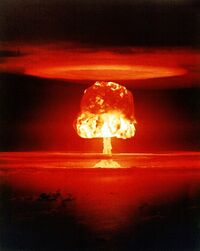
Firestorm (火災暴風), Japan's second thermonuclear test (1963).
In 1960, Japan detonated its first atomic bomb, followed in 1962 by its first hydrogen bomb test detonation. Both test were carried in the atolls of Nan'yō. The H-bomb provided a deterrent for Japan in the growing Southeast Asia unrest and crisis of the 1960s. However, in 1969 Japan officially declared that its nuclear arsenal acted only has defensive measure and that it would collaborate to control and prevent the spread of nuclear proliferation in Asia and Oceania.
As Sanzō Nosaka health deteriorated at the end of 1963, he designated Sota Kita as his successor becoming General Secretary of the Workers and Farmers Party in 1964. Kita was already President of the Council of Ministers in 1963.
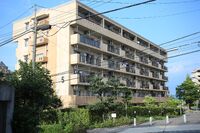
Housing Corporation's Basic Unit of the 1950s.
The I and II National Economic Plans (1954-1958 and 1959-1963) were centered around post war industrial recovery of the heavy industry, energy production, allocation of resources, public works, collectivization of agriculture and access of water and electricity to all households. The sudden surge of refugees added housing in the II National Economic Plan as a priority. Not all the goals of the I Plan were accomplished and idea of self-reliance on natural and manufactured goods was abandoned and reoriented to importations from United America.
Major earthquakes were the ones of 1961, 1963 (Kuril Islands) and 1964.
| Elections National Diet | 1954 | 1959 | 1964 | |
|---|---|---|---|---|
| Party | Seats (% votes) | Seats (% votes) | Seats (% votes) | |
| Workers and Farmers Party | 268 (67%) | 322 (80.5%) | 320 (80.0%) | |
| Constitutional Democratic Party | 82 (20.5%) | 44 (11.0%) | 45 (11.3%) | |
| Christian People's Party | 5 (1.3%) | 6 (1.5%) | 5 (1.2%) | |
| Dharma Welfare Party | n/a | 12 (3.0%) | 14 (3.5%) | |
| National Cooperative Party | n/a | 16 (4.0%) | 16 (4.0%) | |
| Sōhyō-Labour Political Front | 45 (11.2%) | n/a | n/a | |
| Total Seats | 400 | 400 | 400 | |
Transition (1965-1969)[]
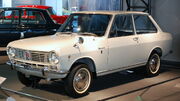
The low-cost Nissan-Yokohama MW Sunny became a symbol of the Japanese prosperity of the 1960s under the new economic policies - also a major export item to Asia.
The death of Sanzō Nosaka, President of the State Council 1954-1965, marked the end of the authoritarian and undemocratic rule of the WFP.
Sota Kita, Nosaka's designated successor and also General Secretary of the WFP and party hardliner was forced to step down from all his governmental and party posts as the majority of the Plenary of Central Committee in 1965 disapproved a continuation of the authoritarian rule, lack of party democracy and the prospect of new purges as in the 1950s. Tetsu Katayama was recalled to preside the Council of the People's Ministers (CPM), now controlled by the centrist and reformist factions of the WFP.
The political report of Kenji Miyamoto to the V Congress of the WFP in 1966 criticized the authoritarian practices and cult of personality of Sanzō Nosaka. The political report shocked the delegates as it was widely known but no officially recognized and disapproved. The Congress approved several measures to eradicate Nosako's Cult of Personality and the rehabilitation of members declared enemies of the working class in the 1950s and 1960s. A new Central Committee was elected that set aside most of Nosaka's allies and partisans. A summary of Miyamoto's report was broadcast on the main radio news bulletins at the end of the V Congress shocking a whole nation of the public acknowledgment of political errors.
The approved Rectification of Ways policy ended press censorship, release and amnestied political prisoners and guaranteed free elections.
The new policy also started the process of dissolution of the WFP. The debates of VI Congress of 1967 were broken as at least three party platforms - one calling for the dissolution of the WFP - were presented but none approved. Congress delegates left and meet separately and voted to dissolve the WFP and establish a new political party. So the four main factions became separate parties: Japanese Communist Party (JCP), Japanese Socialist Party (JSP), Socialist Masses Party (MSP, Bridge or Dialogue Group) and Japan Proletarian Party (JPP, Change Group).
The MSP and JSP representatives had more than one-third of the seats blocking the possibility of dissolving the National Diet and calling early elections. The CPM was rebound with members of the MSP, JPP, JSP and independent socialists, the new majority of the National Diet.

Tokyo Imperial Palace National Museum Complex.
The former cultural policy of ignoring or abolishing the past was overturned, being exemplified by the reopening of the Tokyo Imperial Palace as a national museum under the care of the Imperial Museums Agency.
The preliminary work of the III National Economic Plan was redone on the death of Nosaka and as control of reformists and centrist groups of the WFP spread to the bodies in charge of economic planning. The III National Economic Plan (1964-1968), tough not abandoning the heavy industry as its priority, set goals in the production of consumer goods and the improvement of the food industry, agriculture and fisheries. The III Plan also began to decentralize decision making from the previous iron grip of the Ministry of Development and Planning and various central bodies that had produced internal deadlocks in the past.
| Elections National Diet | 1964 | 1967
(After dissolution of WFP) | |
|---|---|---|---|
| Party | Seats (% votes) | Seats | |
| Workers and Farmers Party | 320 (80.0%) | n/a | |
| Socialist Masses Party | n/a | 128 | |
| Japan Proletarian Party | n/a | 86 | |
| Japanese Communist Party | n/a | 64 | |
| Japanese Socialist Party | n/a | 42 | |
| Constitutional Democratic Party | 45 (11.3%) | 45 | |
| Christian People's Party | 5 (1.2%) | 5 | |
| Dharma Welfare Party | 14 (3.5%) | 14 | |
| National Cooperative Party | 16 (4.0%) | 16 | |
| Total Seats | 400 | ||
Tenkō (Change of Direction, 1969-1979)[]
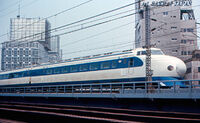
Shinkansen (0 series) fast train.

IV National Economic Plan Nuclear Power Plant of Ikata (Shikoku Region).
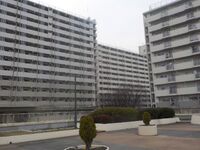
Housing Corporation Basic Unit of the 1970s.
Mosaburō Suzuki, General Secretary of the Japan Proletarian Part and Prime Minister (1969-1976) began the Tenkō (Change of Direction) were several economic, political and social reforms were enacted. For example, the political partisanship of the judiciary was prohibited and the law courts were independent and protected of the influence and power of state authorities. A new and controversial Citizenship Law was enacted allowing Chinese and Koreans that emigrated in the 1950 gain full citizenship.
Although, Tenkō only lasted ten years its influence lasted in time and marked a replacement of the old revolutionary generation that existed during the Japanese Empire with the one new. The hardships of the war and the first years of the triumph of the Revolution led to new lifestyle less strained by the need to survive. In addition, with the acquisition of nuclear weapons, Japan enjoyed a defensive security.
The official policy to fulfill demands of consumer goods marked a shift in industrial production that marked the start of successful electronic and chemical industries. Relationships with Korea and China were reestablished, at first with trade agreements and later treaties that settled most post-war issues. The cultural exchange programs also opened up travel of Japanese citizens to the neighboring countries, tough restrictions on Chinese and Korean descends were kept for some time.
In tune with the end of cultural censorship, the Ministry of Culture was established with the end of promoting traditional art forms, foreign cultural exchange, a new network of open cultural centers and museums. It also opened musical distribution and production to cooperatives after closing the official music state company. The Ministry of Culture engages in a large-scale renovation of palaces and temples as part of the re-appropriation and renewal of Japanese historical heritage. Many were transformed in museums, cultural centers or returned to their original use as religious or ceremonial centers. The opening of the Kyoto Imperial Palace and Katsura Imperial Villa as museum was the highlights of the new cultural policy of relooking and reassessing the past.
A liberation of culture and social mores characterized this period. For example, women smoking in public became common. Several measures that restricted their entry to the workforce and education were ended. Divorce procedures were made easier. Birth control and contraception became widely available. The distinction of men's and women's trade unions was legally ended. Equal pay and welfare benefits for women became an important issue in negotiations with workplace administration.

Shopping Center Coop Days.
The Central Department Stores were allowed to open branches in the same cities and the option to change from state-owned to a worker owned-cooperative. Licenses for cooperatives to run department stores were also opened. Co-op Kobe and Nada Consumer Co-operative, the already main consumer cooperatives, and others, started to have locals in place other than the big cities.
From the Tanegashima Space Center, Japan launched its first space satellite, first manned orbital flight and first space probe to the moon.
Members of the right-wing faction of the Socialist Party split from it to establish the Democratic Socialist Party (DSP, 1975). The first political right camp parties are formed by former members of the Constitutional Democratic Party (1953-1976) thus ending the collaboration of the democratic right with the left camp parties: Democratic Reform Party (DRP, 1970 to date) and National Democratic Party (NDP. 1975 to date).
The IV, V and VI National Economic Plans (1969-1973, 1974-1978 and 1979-1983) not abandoning altogether industrial development, called for the expansion of the educational and scientific output and the promotion of new technological industries as mean to improve production and quality of industrial and consumer goods. The dependency on foreign oil and coal called for an extensive nuclear energy program to a planned 60% of national power production in the last two plans. The V and VI Plans started the trend of giving economic incentives for the development of industry and infrastructure, like the fast train network and nuclear power.
Major earthquakes were the Hyūga-nada and Tokachi earthquakes of 1968, 1974 and 1978.
| National Diet Elections | 1969 | 1974 | |
|---|---|---|---|
| Party | Seats (% votes) | Seats (% votes) | |
| Japan Proletarian Party | 151 (37.6%) | 160 (39.8%) | |
| Socialist Masses Party | 61 (15.2%) | 29 (7.3%) | |
| Japanese Socialist Party | 46 (11.4%) | 51 (12.8%) | |
| Japanese Communist Party | 41 (10.3%) | 48 (12.1%) | |
| Constitutional Democratic Party | 52 (13.0%) | 42 (10.5%) | |
| Dharma Welfare Party | 24 (6.0%) | 34 (8.4%) | |
| Democratic Reform Party | n/a | 21 (5.3%) | |
| National Cooperative Party | 22 (5.5%) | 11 (3.0%) | |
| Christian People's Party | 4 (1.0%) | 3 (0.8%) | |
| Total Seats | 400 | 400 | |
Stabilization and Change (1979-1994)[]

H-II launch vehicle, carrying communications satellite CS-3 of the National Japanese Aerospace Agency.
The death of Mosaburō Suzuki (1976) and the National Diet elections of 1979 marked the end of the hurdle of reforms. His successor Reina Fujioka (1976-1984) continued with reforms but in a more slow pace trend and prioritizing on the economic, financial and educational sectors. The need of stable governments also stopped the reforms, as the elections of 1979 and 1984 gave no clear majority to the JCP and the JPP.
The election of Kumiko Itou as president of the State Council marked a return to reforms. Under her leadership a new Citizenship and Resident Law was passed allowing no Japanese living for at least ten years were to gain citizenship and political rights and eased the register of Korean and Chinese names. A decree of the State Council elevated Nan'yō to national region in 1978.
However, no major social experiments or reforms were taken in large scale. The educational system was the only field were new social experiences were widely out carried out, especially in teacher training, school services and curricula reform.
A source of great pride for Japanese society came in the breakthroughs of space exploration. The investment of the previous decade enable to put a permanent space station orbiting Earth. The facilities of Kauaʻi Space Center of Hawaii were expanded becoming the Pacific's largest spaceport.
The Socialist Masses Party was dissolved in 1985 after its electoral fall in the National Diet elections of 1984. The Social Labour Union was founded in 1991 by a merger of the Japan Proletarian Party (JPP), and New Left, feminist and emigrant groups.
The VII and VIII National Economic Plans (1984-1988 and 1989-1993) as in the previous two plans focused in education, technology, and nuclear power. The VII Plan ended production quotas, only mandate moving average production, and centered in the distribution of goods and services. As in the VIII Plan, incentives were also given to the banking and financial institutions as indicators of planned output of production, distribution or consumption.
Major earthquakes were the ones of 1983, 1984, 1993 and 1994 (offshore Sanriku and Kuril Islands).
| National Diet Elections | 1979 | 1984 | 1989 | |
|---|---|---|---|---|
| Party | Seats (% votes) | Seats (% votes) | Seats (% votes) | |
| Japan Proletarian Party | 116 (27.2%) | 108 (25.4%) | 65 (15.2%) | |
| Japanese Communist Party | 109 (25.5%) | 111 (26.1%) | 73 (17.2%) | |
| Japanese Socialist Party | 53 (12.4%) | 55 (13.0%) | 87 (20.5%) | |
| Dharma Welfare Party | 42 (9.8%) | 48 (11.3%) | 59 (13.9%) | |
| Democratic Socialist Party | 23 (5.3%) | 30 (7.0%) | 76 (17.9%) | |
| Socialist Masses Party | 17 (4.1%) | 6 (1.5%) | n/a | |
| Democratic Reform Party | 26 (6.2%) | 30 (7.1%) | 33 (7.8%) | |
| National Democratic Party | 22 (5.1%) | 26 (6.2%) | 25 (5.8%) | |
| Constitutional Democratic Party | 6 (1.5%) | n/a | n/a | |
| National Cooperative Party | 10 (2.4%) | 9 (2.1%) | 6 (1.5%) | |
| Christian People's Party | 2 (0.5%) | 1 (0.3%) | 1 (0.2%) | |
| Total Seats | 426 | 424 | 425 | |
The Opening (1994-2006)[]

Kawanishi K-320 flying boat operated by National Japanese Airways and used in the Pacific Islands and Hawaii routes.
By 1994, Japan began a series of economic reforms to incorporate aspects of capitalism (or self-regulatory economic mechanisms as it was called) into its economy. Japan's economy partially recovered with the end of the planned economy, but did not fully recover because of international economic crisis that also hit Japan as it began its opening to foreign trade.
Hikari Yoshida's premiership (1992-2006) pushed for several economic reforms under his electoral manifesto Lets Share Our Wealth of 1994. However, in some parts of the society, it would cause impoverishment. Tough, the blatant consumerism it promoted would be criticized along the lack of improvements in social welfare benefits and services.
The Opening also meant that under President Ichiro Katou Japan would establish a more permanent and peaceful relationship with her neighbors. The Shanghai Charter established the East Asian Community with Japan as one of its members.
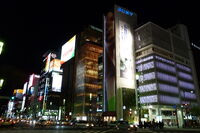
The lights of Ginza
An example of the consumerist policies of the Opening was the urban renewal of Ginza District that made it a popular upscale shopping area of Tokyo, with numerous department stores, boutiques, restaurants, private clubs and coffeehouses located in its vicinity.
The South Sea Scandal of 2006, that implied in cases of corruption several notable members of Yoshida's DSP led to his Cabinet being removed by a no confidence vote of the National Diet. Honoka Matsuoka of the SLU and new premier was able, as part of the agenda of the new cabinet, to gather the two-third majority that dissolved the National Diet and have early elections of it in the same year. The early elections were a condition President Jo Soo-Jin had agreed with Matsuoka in order to gather a ruling coalition in the National Diet for her Cabinet.
The IX National Economic Plan (1994-2003), besides being long in its implementation was more indicative and goal driven. Foreign trade was took as key indicator for a number of industries. The service sectors were given indicative goals in quality and availability.
Major earthquakes were the ones of 1995, 1998, 2001, 2003, 2004 and 2005 (two) and 2006 (Kuril Islands)
| Elections National Diet | 1994 | 1999 | 2004 | |
|---|---|---|---|---|
| Party | Seats (% votes) | Seats (% votes) | Seats (% votes) | |
| Democratic Socialist Party | 95 (22.3%) | 96 (22.6%) | 102 (23.9%) | |
| Japanese Socialist Party | 90 (21.1%) | 87 (20.5%) | 96 (22.6%) | |
| Social Labour Union | 73 (17.1%) | 85 (20.0%) | 93 (21.9%) | |
| Japanese Communist Party | 61 (14.3%) | 55 (13.0%) | 46 (10.9%) | |
| Dharma Welfare Party | 51 (12.0%) | 50 (11.7%) | 40 (9.4%) | |
| Democratic Reform Party | 28 (6.5%) | 26 (6.2%) | 29 (6.9%) | |
| National Democratic Party | 21 (4.9%) | 20 (4.7%) | 16 (3.8%) | |
| National Cooperative Party | 7 (1.6%) | 5 (1.2%) | 2 (0.5%) | |
| Christian People's Party | 1 (0.2%) | 0 (0.1%) | 0 (0.1%) | |
| Total Seats | 427 | 424 | 424 | |
Rentai (2006 to date)[]
The premiership of Honoka Matsuoka (2006-2016) returned to distributive policies that were abandoned by her previous predecessor. It began a trial basis of the universal basic income and removed restrictions on the access to welfare services that the previous administration had enacted. The reconversion of the workforce and industry become a priority being added to the National Workforce Plan of 2010-2015 and a goal of the X Economic Plan.
Currently, or least in 2019, Japan has a rapidly growing economy, and in just less than twenty years had pushed millions of citizens out of war poverty and repaired all of the Japanese infrastructure. Japan has become one of the world's largest economy, and is expected to surpass United America and Europe in the near futures.
Severely hit by the South Seas Scandal (2006) the Democratic Socialist Party (DSP) faced several electoral and leadership crisis that led to its reunification with the JSP in 2014, some its members went to the DRP.
The X and XI National Economic Plans (2004-2013, 2014-2023) called for improvements in the electronic and computational infrastructure. It also prioritized improvements on the national health system and care of old age. Both plans also called for the development and production of renewable energy sources.
Major earthquakes were the ones of 2007 (two and Kuril Islands), 2008, 2009, 2010 (two), 2011 (record six), 2012 (two), 2013, 2015, 2016 (three), 2018 (two).
| Elections National Diet | 2006 | 2011 | 2016 | |
|---|---|---|---|---|
| Party | Seats (% votes) | Seats (% votes) | Seats (% votes) | |
| Social Labour Union | 100 (23.5%) | 110 (25.9%) | 103 (24,1%) | |
| Japanese Socialist Party | 77 (18.0%) | 79 (18.6%) | 148 (34.8%) | |
| Democratic Socialist Party | 75 (17.5%) | 62 (14.5%) | n/a | |
| Japanese Communist Party | 60 (14.0%) | 53 (12.5%) | 48 (11.3%) | |
| Dharma Welfare Party | 49 (11.5%) | 53 (12.4%) | 52 (12.1%) | |
| Democratic Reform Party | 34 (8.0%) | 37 (8.7%) | 43 (10.2%) | |
| National Democratic Party | 26 (6.0%) | 26 (6.1%) | 28 (6.5%) | |
| National Cooperative Party | 6 (1.4%) | 5 (1.1%) | 3 (0.8%) | |
| Christian People's Party | 0 (0.1%) | 1 (0.2%) | 1 (0.2%) | |
| Total Seats | 427 | 426 | 426 | |
State and Government[]
The Constitution of the PR of Japan declares that it is a unitary socialist state under the people's democratic dictatorship.
The constitution guarantees the fundamental freedoms of movement, thought, expression and religion, equality before the law, to vote and participate in the political process, to peaceful assembly and association, rights of due process of law and trial by jury. Social and economic rights such as health, education, social security, housing, strike and join unions are recognized by the State for all people. The linguistic and cultural rights of non-Japanese communities (i.e. Ainu, Koreans, Chinese and Polynesians) are constitutionally recognized.
Universal adult suffrage for both sexes over 20 years of age was introduced in 1953.
Although the Constitution recognizes the right of political pluralism, only the "democratic parties" of the Revolution and others are allowed to register in the elections and participate at all levels of government.
The Constitution, drafted by the National Diet of 1954, kept a parliamentary system of government, but with a collective head of state in the President and members of the State Council. One main difference with other parliamentary systems is that the legislature serves in full its five year term and cannot be dissolved by the heads of state or government.
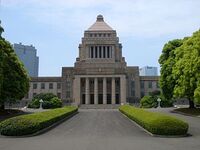
Building of the National Diet of PR Japan.
The National Diet (国会 Kokkai) is the unicameral national legislature and the highest organ of state power of the PR of Japan. The members of National Diet, representatives, are elected for a five-year term. The National Diet cannot be dissolve, unless two-thirds of its members vote to do so and elections are called within a month. The plenary sessions of the Diet are held at least twice every year. The National Diet elects the State Council, the Council of the People's Ministers, the Supreme People's Court and the People's Inspectorate on the first plenary session after the general election of the National Diet. Between the sessions of the National Diet its representatives elect a Standing Committee that presides its normal session, carry out clerical and administrative functions, and call for special sessions of the National Diet. There are no by-elections. If a vacancy arises from the death or resignation of a representative, the next un-elected candidate of the party list is offered the seat.
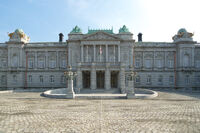
Akasaka Palace, seat of the State Council.
The State Council (國務院 Kokumu-in) is the collective head of state of Japan, elected by the National Diet. The State Council consists of a President, two to six councilors and a nonvoting secretary. The National Diet defines the number of members of the State Council[2]. Its function are to issue statutory decrees, legally binding interpretations of constitution and laws, conducts foreign affairs and the national defense policy. The diplomatic role of head of state solely rests with the President. The commander-in-chief of the Japan Armed Forces is the President. The State Council formally exercises its functions collectively; however, its president is a pivotal political figure. Under Nosaka (1954-1965), the huge influence its President over all state and government institutions was established.
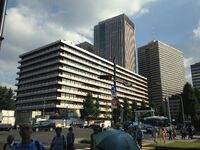
Central Buildings of the CPM.
The Council of the People's Ministers (CPM) is the highest administrative body of Japan. The President of the Council of Ministers chairs its sessions. assisted by three Deputy Ministers, and consists of the Ministers of State and other executive authorities. The National Diet elects the CPM. The legislature can also vote a censure against the CPM and if it is approved it then process to name a new one[3]. The main function of CPM is to implement the general state policy. Every People's Ministers of State are free to carry out their duties as long as in accordance with the general state policy as laid out by the State Council and/or the National Diet.

Supreme People's Court
The Supreme People's Court is the court of last resort and the highest judicial authority to interpret the Japanese constitution - along the State Council - and decide questions of national law (including local bylaws). The National Diet elects its members. The Supreme People's Court is also responsible for nominating judges to lower courts, determining judicial procedures, overseeing the judicial system, including the activities of public prosecutors, and disciplining judges and other judicial personnel. Candidates for judgeship must pass the National Judicial Examination.
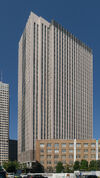
Central Offices of the People's Inspectorate.
The People's Inspectorate purpose is to find and eliminate inefficiency and corruption within the state’s administration. Its main functions are to audit, evaluate, investigative and report on the expenditures and budgets of the state administration. The National Diet elects the members of its Managing Board. The People's Inspectorate is responsible for scrutinizing all levels of the administration and state owned enterprise. Its regional, prefecture and local bureaus of complaints are open to any citizen to file a complaint against anybody of the state administration. The People's Inspectorate can either suggest corrective measures to correct issues of neglect or malfunction, or send the complaint to the judiciary and the National Diet.
| Chairman of the National Revolutionary Council | ||||
|---|---|---|---|---|
| Name | Portrait | Term | Party | Notes |
| Sanzō Nosaka | 
|
1953-1954 | Japanese Communist Party
-> Workers and Farmers Party (formed in 1953) |
|
| Presidents of the State Council | ||||
| Sanzō Nosaka | 
|
1954-1965 | Workers and Farmers Party | General Secretary of the Workers and Farmers Party (1954-1964). Reelected in 1959 and 1964. Died in office. |
| Kenji Miyamoto | 
|
1965-1974 | Workers and Farmers Party -> Socialist Masses Party (formed in 1967) | General Secretary of Workers and Farmers Party (1965-1967). Reelected in 1969. |
| Tetsuzo Fuwa | 
|
1974-1984 | Japanese Communist Party | Made first official state visit to United America and the Philippines. Reelected in 1979. |
| Kumiko Itou | 
|
1984-1989 | Japan Proletarian Party | First woman elected President of the Council. Made first official state visit to China and Korea. |
| Ichiro Katou | 
|
1989-1997 | Japanese Socialist Party | Died in airplane crash. Reelected in 1994. |
| Masuyo Yamauchi | 
|
1997-2004 | Japanese Socialist Party | Elected to complete 1994-1999 term. Reelected in 1999. |
| Jo Soo-Jin[4] | 
|
2004-2011 | Social Labour Union | First president of Korean ancestry. Reelected in 2006. |
| Wang Ru[5] | 
|
2011-2016 | Japanese Communist Party | First president of Chinese ancestry. |
| Makoto Yamashita | 
|
2016 to date | Social Labour Union | |
Political Parties[]
Japanese politics distinguishes three main ideological camps or families. National government as being led by the left camp, in occasions sustained by the center o right camps. The right camp has being the political expression of the groups not associated to the left or of the few remaining pro capitalist circles still existing in Japan.
- Left Camp
- Workers and Farmers Party (労働農民党, Rōnōtō WFP) 1953-1967. The dominant left party, of the de facto one-party state from 1953 to 1967. The WFP was established by the merger of existing communist, socialist, Christian socialist, pacifists parties and groups.
- Japanese Communist Party (日本共産党, Nihon Kyōsan-tō JCP). 1967 to date. Established from the dissolved WFP. It is the recreation of the pre 1953 party of the same name. The JCP is the historical and traditional party of the left and urban workers interests and networks.
- Japanese Socialist Party (日本社会党, Nihon Shakaitō JSP) 1967 to date. Established from the dissolved WFP and recreation of the pre 1953 party of the same name and with the same membership before its merger in the WFP.
- Socialist Masses Party (社会大衆党, Shakai Taishutō SMP) 1967-1985. Established from the dissolved WFP. It was left centrist faction of the WFP and created as dialogue group to reform the worst excess of the Nosaka era. After its dissolution, its membership went to the JCP, JSP and Proletarian Party.
- Japan Proletarian Party (日本無産党, Nihon Musantō JPP) 1967-1991. Established from the dissolved WFP and dissident labour unions. The JPP is a recreation of the pre 1953 party of the same name. The JPP was the political and social main expression of the Tenkō (change of direction) movement and included dissidents expelled from the orthodox JCP or WFP.
- Democratic Socialist Party (民主社会党, Minshu Shakai-tō DSP) 1975 to date. The DSP was established from a split of the right-wing faction of the Socialist Party. Severely hit by the South Seas Scandal of 2006. After its reunification with the JSP in 2014, some its members went to the DRP.
- Social Labour Union (社会労働組合, Shakai Rōdō Kumiai SLU) 1991 to date. Formed from the merger of the JPP, pacifists parties, ecological awareness, feminists, and Korean and Chinese migrants groups.
- Center and Interest Camp
- Christian People's Party (キリスト教人民党, Kirisutokyō Jinmintō CPP). 1953 to date. The CPP was establish as the political vehicle of the Japanese Catholics. Has strong ties with the Catholic clergy and the Christian socialists not part of the WFP.
- National Cooperative Party (国民協同党, Kokumin Kyōdōtō, NCP), 1958 to date. A centrist party promoting cooperativism and agrarian interests.
- Dharma Welfare Party (ダルマ福祉党, Daruma Fukushitō DWP), 1956 to date. A center-left non-Marxist party that advocates socialism based on the principles of Buddhism (Buddhist socialism) and would later include Engaged Buddhism. The majority of the pacifist, nuclear disarmament and environmental awareness movements had an early expression or were promoted by the DWP. The DWP was member of the ruling coalition from 1969 to 1979.
- Right Camp
- Constitutional Democratic Party (立憲民政党, Rikken Minseitō CDP) 1953-1976. The CDP was the main pro-government liberal party before 1969 and united the former liberal and anti-military politicians of the Japanese Empire. The CDP participated in the draft of the Constitution of the PR of Japan and voting its basic right chapter and afterwards consistently voted and supported mos of the WFP government's proposals. However, the CDP was widely considered until 1969 an uncritical ally of the WFP. Had one member regularly elected to the State Council every five years (1954-1969). Most of its membership joined either the DRP or NDP after the party was dissolved in 1976.
- Democratic Reform Party (民主改革連合, Minshu-Kaikaku-Rengō DRP) 1970 to date. The DRP is a liberal and social liberal party established by dissidents of the CDP. Until now it has been the only Right Camp that has been part of the Council of the People's Ministers (1989-2006).
- National Democratic Party (国民民主党, Kokumin Minshutō NDP) 1975 to date. The main party of Japanese nationalism, liberalism and agrarianism.
Economy[]
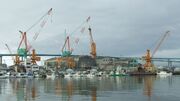
Fukuoka Shipbuilding dock.
The PR of Japan as a socialist state distinguishes according to the ownership of property the following: state-ownership, collective-ownership, and personal property, and their use and rights. Legislation approved in 1996 recognize certain forms of private property such as individual and family enterprises. Despite certain liberation of the economy, heavy industry, energy, and infrastructure are still state owned and subject to the goals of the National Economy Plans.
A third type of property, the socially owned enterprise or social enterprise, different from a cooperative, was established in 1982. Social enterprises can be structured as a for-profit or non-profit. A social enterprise's main purpose is to promote, encourage, and make social change. Social enterprises are businesses created to further a social purpose in a financially sustainable way.
The property of land is either state or collective, the later most common and arranged in production cooperatives of various forms. State farms and enterprises are limited to exportable cash crops or products. About 25% of the rice is produced and marketed by state farms.
The nationalization and dissolution of the zaibatsu, the heart of Japanese economy, quickly brought to state-ownership of all large industries and the majority of the middle industries, trade and financial companies. Industries were broken down into regional conglomerates (e.g. iron and steel, petrochemical, textiles, shipbuilding, transport, fishing fleets) or industrial combines, (e.g. banking, automobiles, chemical and fuel shipping and processing) or centralized (e.g. banking and foreign trade).
Pursuit of full employment was a stated goal of the post war economic reconstruction. Labor Exchanges and Placement Offices were also opened for registering women, along health and pension benefits for them right after the triumph of the Revolution. Post War rationing continued well into the 1950s, with gasoline to be the last one to be revoked in 1963.
The most important state companies are the Japanese National Railways (JNR), the National Japanese Airways (NJA), the Postal Services Agency, the Nippon Yusen/NYK Line, the Nippon Telegraph and Telephone (NTT), the National Bank of Japan, the Postal Savings Bank, the Housing Corporation, the Industrial Bank of Japan, and the Japan Central Foreign Trade Board.
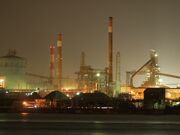
Kashima Steel Works.
The main industrial zones are in the Kanto region surrounding Tokyo, (the Keihin industrial region) and the Kansai region surrounding Osaka (the Hanshin industrial region) and the Tōkai region surrounding Nagoya (the Chūkyō–Tōkai industrial region. Other industrial centers include the southwestern part of Honshū and northern Shikoku around the Seto Inland Sea (the Setouchi industrial region); and the northern part of Kyūshū (Kitakyūshū). In addition, a long narrow belt of industrial centers called the Taiheiyō Belt is found between Tokyo and Fukuoka, established by particular industries that have developed as mill towns.
The service and consumer sector is either state, collective, socially owned, personal or private. Before the reforms of 1996 personal property in some cases had acquired a larger scale then stated definition of personal. For example restaurants, retail business and sale of imported goods for personal use such as clothes, shoes, jewelry, etc.
The National Economic Plans (NEP) consists of a series of nationwide economic plans and programming and are the key policy in economic and social planning in Japan. Until IV National Economic Plan (1969-1973), economic planning was highly centralized, from onward the plans considers decentralization and regional goals. The Ministry of Economic Planning produces and plans the directives and goals. The former State Planning Commission and the, State Supplies Commission shared roles and the supervision of the NEP until they were disbanded and all functions transferred to the Ministry of Economic Planning.
The development agencies (DA) were established for the purpose of furthering economic and social development and coordinating the goals of the National Economic Plans. The following DAs were established: Karafuto DA (1955 to date), Hawaii DA (1956-1970), Hokkaido DA (1956-1978) and Nanyo DA (1956-1993).
Foreign trade is a state monopoly controlled by the Japan Central Foreign Trade Board (JCFTB). The importation of natural resources such as raw materials and fuel managed by a selected number of state enterprise. The exports are done thru certificates issued by the JCFTB. The major exports of the PR of Japan are automobiles, machinery, steel, shipbuilding, consumer electronics, computers, petrochemicals, pharmaceuticals, bioindustry, shipbuilding, aerospace, processed food, textiles and luxury goods such as pearls and silk.
However, in 1996 several decrees and laws opened or enabled state enterprises and a selected number of cooperatives to engage actively in world commerce. However, foreign trade is still regulated by means of national bilateral trade agreements or in some cases fully opened for certain natural resources, food and manufactured goods.
The participation of workers in the decision-making in state-ownership industries and workshops is limited to industries that are not part of the defense sector or of national security concern. In all other industries there is a joint management council that deal with conditions of work, work training, security and health and social welfare. The council are compose of an equal number of members of the administration and workers’ representatives.
Labour and Cooperatives[]
The General Council of Trade Unions of Japan (日本労働組合総評議会 Nihon Rōdōkumiai Sōhyōgikai, often abbreviated to Sōhyō 総評),is the national industrial union of Japan. Membership of individual and federal trade unions to the Sōhyō is obligatory. Its most important federations are the ones of the railroad, postal, automobile and education workers. Members of the parties of the left camp usually staff the leadership and administrative bureaucracy. The Central Union of Japanese Cooperatives is the national confederation of the cooperatives. Cooperative societies are the majority of enterprises in the agriculture, fisheries and service. Consumer cooperatives usually run the retail business of agricultural and sea products.
The Japanese workforce is usually divided in blue-collar, white-collar and pink-collar. The later in its majority and typically female-dominated. They include jobs in the beauty industry, nursing, teaching, secretarial work, personal care and service or child care. Pink-collar workers are usually discriminated in pay and benefits as women are still expected to marry and abandon work.
An exception is agriculture were women have traditionally and still outnumber men. A departure from the past after the Revolution is that women are more involved in leadership roles in the agricultural committees and in the day-to-day running and top management of cooperatives and state farms.
As part of the cultural changes of the Tenko Period, a massive grants roots movement began to encourage and train women to become "emancipated farming ladies". Several schools were created to train women about agriculture and to draw women into rural areas. Along the modernization of farming in the late 1960s began to attract women back to farming. Young women who live in the city and work part-time on the farm formed new agricultural collectives. Becoming known as farm gals, or nōgyaru. These new collectives changed the traditional livelihood in rural villages.
The abrupt and massive involvement of women in the workforce that started in 1953 also opened education institutions to women. However, the demands that women receive equal pay for equal work came late, as unions were established separating men and women in the same workplace.
Society[]
Sports in Japan are a significant part of the post revolution culture. Both traditional sports such as sumo and martial arts, and Western imports like football, union rugby, and baseball are popular with both participants and spectators. Football and baseball were also part of the diplomatic relations of Japan in the 1960s and 1970, as jocularly stated by former President Tetsuzo Fuwa in 1975, Football diplomacy with our East Asian neighbours and baseball diplomacy with the Americans.
Sumo wrestling is considered Japan's national sport. The Japan Professional Football League is Japan's largest professional sports competition in terms of television ratings and spectators.
The main public Holidays of Japan are the following.
- 1 January: New Year's Day (Obligatory Public Holiday)
- 3 February: Setsubun
- 15 January: Coming of Age Day (Obligatory Public Holiday)
- 3 March: Hinamatsuri
- 8 March: International Women’s Day (Obligatory Public Holiday)
- 20/21 March: Vernal Equinox Day (Obligatory Public Holiday)
- 8 April: Hanamatsuri (Flower Festival), Buddha’s Birthday (Obligatory Public Holiday)
- 1 May: International Labor Day (Obligatory Public Holiday)
- 5 May: Children's Day. Equivalent to Dragon Boat Festival and celebrated as such by Chinese and Korean communities (Obligatory Public Holiday)
- 7 July: Tanabata
- 17 August: Constitution of the PR of Japan Memorial Day (Obligatory Public Holiday)
- 22/23 September: Autumnal Equinox Day (Obligatory Public Holiday)
- 18 October: Proclamation of the PR of Japan (Obligatory Public Holiday)
- 1 November - End of Imperialist War against China and the East, signing of Sahngai Treaty in 1958.Also called Peace Day.
- 15 November: Shichi-Go-San
- 23 November: Labour Thanksgiving Day. The old imperial harvest festival Niiname-sai (新嘗祭) (Obligatory Public Holiday)
- 25 December: Christmas Day
- 31 December: Ōmisoka (Obligatory Public Holiday)
Communications and Mass Media[]
| Type | National public broadcaster |
|---|---|
| Headquarters | Tokyo |
| Area served | Japan and its overseas territories |
| Services | Radio services: National Radio (NR I and II), Radio Tokyo, Regional Network, and Radio Japan (shortwave service) Television services: National Television (NTV I and II), Educational TV, Tokyo TV and Yokohama TV. |
| Type | Regional public broadcasters |
|---|---|
| Founded | Regional Broadcasting Law of 1975 |
| Area served | Regions of Japan (nine regions in 1976, later, ten in 1987) |
| Services | Radio services: regional radios (AM/FM) and local radios (FM) Television services: Regional Television (RTV I and II) |
The Nihon Hōsō Kyōkai (NHK) is the national public broadcaster. Its radio and television networks broadcast in Japanese, with some programs and local networks in Korean and Chinese (Mandarin).
The Regional Broadcasting Unions (CHR) provide regional and local radio and television programming. The unions took over the regional and local networks of NHK and part of the Korean and Chinese (Mandarin, Cantonese, Hakka and Hokkien) programs and added Hawaiian and the Micronesian and Malayo-Polynesian languages to its regional programming output.
The main national newspapers are: Shimbun Akahata (of the Japanese Communist Party), Sankei Shimbun (center-right), Nikkei Shimbun, Asahi Shimbun, Mainichi Shimbun, Renmin Ribao (the main Chinese daily newspaper) and Minju Choson (the main Korean daily newspaper). National newspapers print morning and evening editions.
The end of press censorship in 1966 and the liberation of culture from party intervention and relaxation of state control of the arts and mass media in 1969 saw an explosion of publications as independent publishing cooperatives and worker-owned enterprises were established and geared towards interests of a public hungry for recreation and leisure.
Administrative Divisions[]
The PR of Japan is organized in National Regions, National Territories, Metropolitan Prefecture, Prefectures, Districts, Municipalities (includes Towns, Villages and Wards).
Each National Region, National Territory, Prefectural Metropolis, Prefecture and municipality has a chief executive, called a governor in prefectures and a mayor in local governments, or collegiate executive such as an Administrative Board. Most jurisdictions also have a unicameral assembly. Both the executive and assembly are elected by popular vote every four years.
| Level | Administrative Division of Japan | ||
|---|---|---|---|
| L1 | National Region | Metropolitan Prefecture | National Territory |
| L2 | Prefecture | District | |
| L3 | Municipality (Towns and Villages) | Ward | Special Ward (Town and Village) |
- National Regions (Capital)
- Tōhoku (Sendai)
- Kantō (Tokyo)
- Chūbu (Nagoya)
- Kansai (Osaka)
- Chūgoku (Hiroshima)
- Shikoku (Matsuyama)
- Kyūshū (Fukuoka)
- Ryukyu Islands (Okinawa)
- Hawaii[6] (Honolulu)
- Hokkaido[7] (Sapporo)
- Nan'yō (South Seas Islands)[8] (Saipan)
- Metropolitan Prefecture (same limits as the prefecture they are capital of)
- Tokyo
- Yokohama
- Fukuoka
- Osaka
- Nagoya
- Kyoto
- Kobe
- Hiroshima
- Nagasaki
- National Territories (capital)
- Karafuto (Toyohara)
- Kuril Islands
- Bonin Islands
- Northwestern Hawaiian Islands
Science and Technology[]
Science and technology in Japan is focused in vehicle technology, consumer electronics, robotics, medical devices, space exploration and the film industry. Japan's focus on intensive mathematics education and the reverence for engineers in Japanese culture aids engineering talent development.
Since 1950s, Japan has been looking to become less dependent on imported fuel and started to depend on synthetic fuel, nuclear energy and alterntiaves such as geothermal and solar. The main alternative in the 1950s was the production of synthetic fuel by the Fischer–Tropsch process from coal, making at least 30% of the national production of fuel. The II National Economic Plan (1964-1968) provided for major investment in research and development of nuclear energy, followed by geothermal sources.
Armed Forces and Police[]
The old Imperial Army and Navy were disbanded and replaced by the Japanese People's Armed Forces (JPAF). The members of former Imperial Army and Navy were purged of nationalist and conservative officers and soldier. They were discharged, reeducated in concentration camps or extradited for war crimes to China and Korea. Most of the officers and sailors of the Navy were pardoned or reinstated due to the necessity of securing the maritime defense of the homeland and recollect all possible troops from overseas.
In the first years of the PR of Japan, political officers were named in all units of the Armed Forces to secure loyalty to the state and the party by all officers, soldiers and sailors. Their main tasks were to identify, reeducate, discipline or root out unfavorable elements or sympathizers of the old Japanese imperial ideology or militarism. On the normalization of the military discipline and its proven trustworthiness the post of political commissioner began to fell on uniformed military officers. They become largely responsible for administrative tasks such as public relations and counseling, and mainly serve as second-in-command.
The branches of the JPAF are the following:
Japanese People's Army (JPA)
Japanese People's Navy (JPN)
Japanese People's Air Force (JPAF). It also has specialized corps, the Air Defence Forces that control the surface-to-air detection and defense system.
Coastal Safety Force (CSF)
- Japanese Peoples Strategic Force (JPSF), the unified branch of the JPN and JPAF that controls Japan's air and sea-based intercontinental ballistic missiles (ICBMs) - established in 1968.
The National Security Board, successor of the Revolutionary Military Council, and the Ministry of National Defense are in charge administratively of the Armed Forces and elaborate the National Defence Policy.
The commander-in-chief of the armed forces is the President of the State Council, advised by the Minister of Defense and the Unified Joint Staff.
- Police
| National Police | |
|---|---|
| 国家警察 | |
| Agency overview | |
| Formed | 1959 |
| Preceding agency | Local police militias, municipal police and rural police service |
| Jurisdiction | DRP of Japan |
| Headquarters | Tokyo, Japan |
| Agency executive | Yoshie Sato, National Commissioner |
| Parent agency | Ministry of Interior |
| Child agency | Public Security Bureau |
The old police services of Imperial Japan and military police forces of the Kenpeitai (army) and of the Tokkeitai (navy) were disbanded and replaced by local police militias, municipal police and rural police service. The political police Tokubetsu Kōtō Keisatsu (特別高等警察 Special Higher Police), also the Tokkō (特高 Tokkō) was disbanded. However, the functions of the Tokko were reconstituted as the Public Security Bureau.
However, inefficiency, corruption, political favoritism force a centralization into a national force in 1959, the National Police, under the administration and control of the Ministry of Interior.
- Disaster Management
The Civil Defense Corps (CDC, 1955-1972) were voluntary workings unit for fire service, civil defense, shelter management, emergency food production, and evacuation. They were established as part on a exhaustive emergency network to deal with possible bomb strikes from hostile states (i.e., China and Korea). The CDC was dissolved, as Japan's thermonuclear weapons became a powerful deterrent against any hostile attack by nearby states. Natural disaster management and help were moved to the Japanese People's Armed Forces, National Police and National Fire and Rescue Service.
All male civilians between the ages of 12 to 65 years, and females of 12 to 45 years were required to be members of their local CDC. They received training on firefighting techniques, civil defense and elementary first aid.
| ||||||||||||||||||||||||||
Notes[]
- ↑ Celebrated in the PR of Japan as Peace Day, or in its longer form as the End of Imperialist War against China and the East.
- ↑ Constitutional reform of 1964.
- ↑ Constitutional reform of 1969.
- ↑ This is a Korean name; the family name is Jo.
- ↑ This is a Chinese name; the family name is Wang.
- ↑ Referendum of 1954 approved its incorporation to Japan as a National Region.
- ↑ Former National Territory 1953-1976.
- ↑ Former National Territory 1953-1986.

















